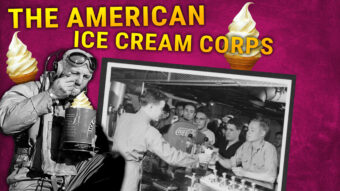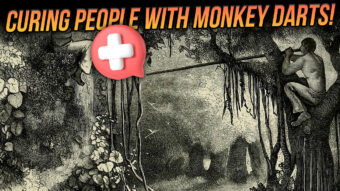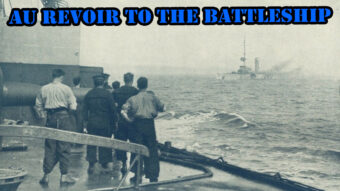
America’s obsession with ice cream goes all the way back to its founding. George Washington spent the modern equivalent of $5,000 on ice cream in a single summer, while Thomas Jefferson returned from his time as U.S. ambassador to France with a hand-cranked churn and a handwritten recipe for vanilla ice cream. Over the next 100 years, ice cream became intimately associated with childhood, seaside vacations, and other comforting experiences – so much so that ice cream became standard fare for patients convalescing in hospitals while, starting in 1921, immigrants arriving at New York’s Ellis Island were fed ice cream as part of their introduction to American life. But what really established ice cream as a cornerstone of the American experience was the 1919 passage of the 18th Amendment to the U.S. Constitution, which banned the manufacture and sale of alcohol in the country. Prohibition forced brewers such as Anheuser-Busch, Yuengling, and Stroh’s to switch to ice cream making in order to stay afloat, while those citizens uninterested or unwilling to seek out speakeasies and other sources of illegal liquor turned to soda fountains and ice cream parlours to fill the social need previously provided by bars and saloons. The Navy had been hit even earlier in 1914, when General Order 99 banned liquor aboard all naval vessels. As a result, between 1916 and 1925, ice cream consumption in the United States skyrocketed by 55%; by the end of the decade, Americans were consuming nearly one million gallons every single day. Curiously, the 1929 Stock Market Crash and the onset of the Great Depression only drove up consumption, as ice cream was among the few comforting luxuries almost anyone could afford to indulge in. Indeed, the popular ice cream flavour Rocky Road, consisting of chocolate mixed with nuts and chunks of marshmallow, was introduced by ice cream manufacturer William Dreyer in 1929 as a metaphor for the hard times he and his fellow countrymen were experiencing.
When the Second World War broke out in September 1939, shortages of sugar, milk, vanilla, and other raw ingredients forced most Allied nations to ban or severely restrict the manufacture of ice cream and other sweet treats, with the British Government even going so far as to recommend carrots on sticks as a patriotic alternative – and for more on that, please check out our previous video How World War II Made Everybody Think Carrots Were Good for Their Eyes. When the United States joined the war in December 1941, it initially followed suit and declared ice cream a non-essential food. However, faced with vigorous lobbying by the International Association of Ice Cream Manufacturers and the National Dairy Council lobbied, the Government reversed its decision, even going so far as to place ice cream on its official chart of Seven Basic Foods – the precursor to the modern and hilariously bad for you “food pyramid” (as previously discussed in our video The Preposterous Pyramid). Meanwhile, the armed forces doubled down on America’s national obsession, adopting a morale-boosting policy of supplying its troops, whenever possible, with as much ice cream as they could eat.
The Navy was particularly keen on ice cream, with Secretary of the Navy James Forrestal assigning the dessert top priority after one of his assistants reported that:
“…ice cream in my opinion has been the most neglected of all the important morale factors.”
Nearly every ship in the fleet larger than a destroyer was fitted with refrigeration and ice-cream making equipment, the sweet treat being served at all hours in the “gedunk bar” or canteen. The origin of the naval slang “gedunk” is disputed, with some historians theorizing that it is an onomatopoeia derived from the sound of food falling out of a vending machine. Others posit that it comes from the popular comic strip Harold Teen, or from a Chinese word meaning “place of idleness.” Whatever the case, the gedunk bar and the ice cream it served became a revered fixture of Navy life and an unlikely source of equality in an otherwise rigidly-structured system. According to one likely-apocryphal story, one day two newly-promoted ensigns aboard the battleship USS New Jersey, flagship of the Third Fleet, went down to the ship’s gedunk bar to get some ice cream. Finding the line unacceptably long, the ensigns decided to pull rank and skip ahead past all the ordinary sailors. The moment they reached the ice cream bar, a voice barked out demanding they get back in line. The ensigns wheeled around to reprimand the insubordinate sailor, only to find their challenger to be none other than Admiral William Halsey, commander of the fleet – waiting his turn in line like everyone else.
But perhaps the most dramatic demonstration of the Navy’s obsession with ice cream came on May 8, 1942 during the Battle of the Coral Sea. At around 11:30 AM, the aircraft carrier USS Lexington was hit by multiple bombs and torpedoes dropped by Japanese aircraft, setting off a series of explosions and fires and completely crippling the ship. At 5PM the ship’s captain, Frederick Sherman, gave the order to abandon ship. The crew obeyed – but not before breaking into and consuming the ship’s entire supply of ice cream, with some sailors filling their helmets and licking them clean before lowering themselves into the Pacific Ocean.
By 1945, demand for ice cream had reached such proportions that the Navy spent $1 million converting a concrete barge into a floating ice cream factory in order to supply the needs of ships too small to carry their own ice cream making equipment. Due to a shortage of metal, early in the war the Navy had contracted Pennsylvania-based firm McClosky & Company to build twenty-four 6,000-ton concrete barges to transport supplies. The barges, which had no engines and had to be towed by tugboats, were unpopular with Navy crews, and most were fobbed off to the Army’s Transportation Corps. The unnamed ice cream barge, however, quickly became one of the most popular ships in the fleet. A marvel of wartime engineering, the barge could churn out 500 gallons of ice cream every day and had refrigerated storage capacity for nearly 2,000 gallons.
But the Navy was not the only service with a sweet tooth. Throughout the war, the Army’s Quartermaster Corps provided American troops with the machinery and ingredients to manufacture some 80 million gallons of ice cream every year; in 1943 alone it shipped out 135 million pounds of dehydrated ice cream mix to the front lines. Given a sufficient source of refrigeration, any soldier could combine the mix with water and standard-issue powdered milk to whip up a tasty frozen treat right on the firing line. But this was apparently not good enough for the Quartermaster Corps, who, in early 1945 as Allied troops were advancing through Germany, built dozens of miniature ice cream factories just behind the lines, allowing half-pint cartons to be brought right to the troops in their foxholes.
Even those without access to standard-issue ice cream found ingenious ways of improvising their own, with some soldiers reportedly mixing snow and melted chocolate bars in their helmets to create makeshift sorbet. But the undisputed masters of battlefield ice cream were pilots. In November 1944, after three months of savage fighting, American forces finally captured the South Pacific island of Peleliu from the Japanese. This was followed by a brief lull in the fighting which left the Marine Corps aviators stationed on the island with little to do. Hoping to raise the morale of his men, J. Hunter Reinburg, commander of a squadron of Vought F4U Corsair fighter-bombers, decided to turn his aircraft into a flying ice cream machine. Under his direction, maintenance crews cut an access hatch in the side of the aircraft’s fuel drop tank and suspended a metal ammunition can inside. Reinburg then filled the can with canned milk and cocoa powder and flew his aircraft to an altitude of 33,000 feet, where the freezing temperatures and the vibration of his engine would, he hoped, churn the mixture into ice cream. But when he landed 35 minutes later, the mixture was still a sticky liquid mess. Realizing that the drop tanks were too close to the aircraft’s hot engine, Reinburg moved the ammunition cans further outboard and tried again. While this time the milk-and-cocoa mixture froze, it still did not have the creamy consistency he was seeking. Reinburg eventually solved the problem by rigging the cans with small wind-driven propellers to churn the ice cream mixture directly as it froze. Army Air Force crews flying bombers like the B-17 Flying Fortress and B-24 Liberator over Europe independently came up with the same technique, though like Reinburg they, too, initially placed the ice cream mixture too close to the engines. Eventually the perfect location for ice cream making was found to be the tail gunner’s turret, which was simultaneously cold and turbulent enough to produce a perfectly smooth, frozen treat – provided, of course, the aircraft and her crew returned in one piece.
The American military policy of providing its troops with ice cream endured well past the end of the Second World War. The only time it was seriously challenged was during the Korean War, when legendary Marine General Lewis “Chesty” Puller complained that ice cream was “sissy food” and that American troops would be tougher if supplied with beer and whiskey instead. The Pentagon disagreed, and issued an official statement guaranteeing that soldiers would be served ice cream a minimum of three times a week.
While many factors contributed to final Allied victory during the Second World War, ice cream played a small but crucial role in maintaining the morale of American troops and reminding them of the home they were fighting for. So the next time you dig into a pint of Ben & Jerry’s, remember to take a moment and thank it for its valiant service.
If you liked this article, you might also enjoy our new popular podcast, The BrainFood Show (iTunes, Spotify, Google Play Music, Feed), as well as:
- How Cap’n Crunch Gave the World the iPhone and the Surprisingly Heated Debate Over Whether He’s Really a Captain
- The Top Secret Navy Mission that Accidentally Rediscovered the Titanic
- Has Anyone Ever ‘Cut the Red Wire’ to Defuse a Bomb?
Siegel, Matt, How Ice Cream Helped America at War, The Atlantic, August 6, 2017, https://www.theatlantic.com/health/archive/2017/08/ice-cream-military/535980/
Funderburg, Anne, Chocolate, Strawberry, and Vanilla: A History of American Ice Cream, Popular Press, University of Wisconsin, https://ift.tt/9fGm2rJ
Hegranes, Emily, We All Scream for Ice Cream: World War II and America’s Sweet Tooth, U.S. Naval Institute, July 25, 2019, https://www.navalhistory.org/2019/07/25/we-all-scream-for-ice-cream-world-war-ii-and-americas-sweet-tooth
Stilwell, Blake, This is How WW2 Marines Made Ice Cream at 30,000 Feet, We Are the Mighty, June 12, 2021, https://ift.tt/AiqwybG
WWII Builders of Concrete Ships and Barges, March 2013, https://web.archive.org/web/20180924224714/http://shipbuildinghistory.com/shipyards/emergencylarge/wwtwoconcrete.htm
O’Brien Caitlin, That Time the Navy Spent a Million Dollars on an Ice Cream Barge, Observation Post, July 21, 2021, https://www.militarytimes.com/off-duty/military-culture/2021/07/21/that-time-the-navy-spent-a-million-dollars-on-an-ice-cream-barge/
Meija, Paula, Why the U.S. Navy Once Had a Concrete Ice Cream Barge, Atlas Obscura, July 5, 2018, https://ift.tt/GoMDSqZ
Dunnigan, James & Nofi, Albert, Dirty Little Secrets of World War II, Perennial, New York, 1994
The post Forgotten History- The U.S. Military’s Obsessive WWII Ice Cream Crusade appeared first on Today I Found Out.
from Today I Found Out
by Gilles Messier - January 31, 2023 at 09:40AM
Article provided by the producers of one of our Favorite YouTube Channels!
-





